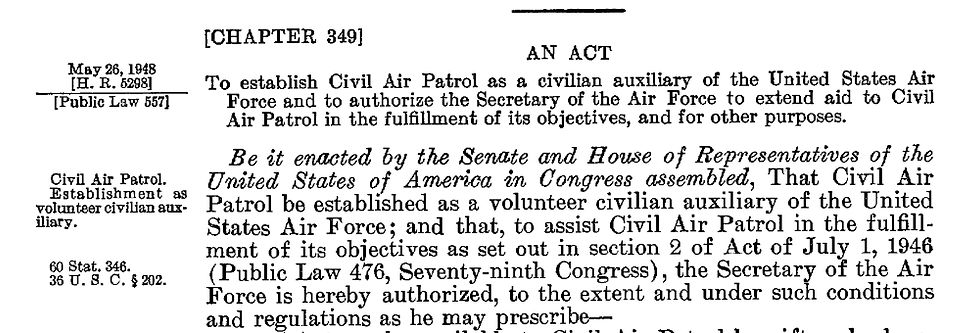
The Civil Air Patrol (CAP) was the brainchild of aviation advocate Gill Robb Wilson; after WWI, he saw a need for a volunteer aviation group to supplement America's military operations in case another war broke out. With the help of New York Mayor Fiorello La Guardia, the new Civil Air Patrol was established on December 1, 1944, days before the attack on Pearl Harbor. CAP's initial focus was reconnaissance flying, but that mission expanded when German submarines began to attack American ships off the US coast. CAP planes began to carry bombs and patroling the US coast, saving many American ships from Nazi submarine attacks. By the end of WWII, the CAP's patrol had flown 24 million miles, found 173 submarines, attacked 57, hit 10, and sank 2.
Following WWII, Congress officially created a separate military branch, the Air Force, on September 18, 1947. Less than a year later, Public Law 80 - 557 was passed officially on May 26, 1948, chartering the Civil Air Patrol as a federally supported non-profit corporation.

Congress made it clear that the Civil Air Patrol would be an aviation-minded volunteer organization under the authority of the Air Force with three primary missions: Emergency services, including search and rescue and disaster relief; aerospace education for the youth and general public; and cadet programs for teenage youth.

Membership in the organization consists of cadets from 12 to just under 21 and senior members 18 years of age and up. These two groups each participate in a wide variety of pursuits. The cadet program is a structured syllabus and an organization based on United States Air Force ranks and pay grades. The older members serve as instructors, supervisors, and operators. All members wear uniforms while performing their duties.

Today, the CAP has grown into a national support organization with more than 60,000 members from all over the US. CAP operates the largest private fleet of Cessna aircraft worldwide and maintains an advanced, nationwide radio communications system. CAP has been involved in every major occupation since WWII, including the Cold War, continuing its history of rescue missions, radio communications, and natural disaster relief. Towards the end of the Cold War, CAP began flying Military Training Route surveys for the Strategic Air Command and Tactical Air Command. In addition, CAP was tasked with homeland security and courier service missions in direct response to the terrorist attacks on 9/11. The CAP responded to the COVID-19 epidemic by organizing the largest mobilization of CAP volunteers since World War II. More than 40 wings have helped deliver supplies, help build and staff field hospitals, transport vaccine vials, and collect more than 20,000 blood through blood drives.

Whether it's responding to disaster relief, assisting in search and rescue, aiding the Red Cross, or helping the Air Force keep our nation safe, the CAP has served the nation, volunteering their time to keep our country safe and responding during times of crisis.
Works Cited

Comentarios